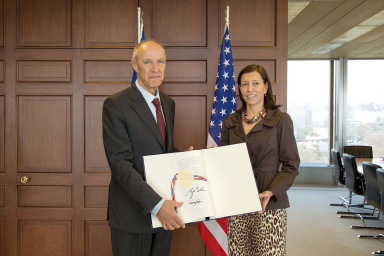The Hague Agreement is the international filing system for design protection that corresponds to the PCT filing system for international utility patent protection and the Madrid filing system for international trademark protection. The progress of the United States toward membership and participation in the Hague Agreement has been slow and at times tortuous. As I blogged here, President Clinton signed the treaty in 1999. Many years passed before the Senate ratified it in 2007. Congress needed to pass enabling legislation which finally happened in 2012. Next the USPTO needed to promulgate proposed Rules, which it did in 2013. The next important step was for the United States to deposit an “instrument of accession” to the Agreement with WIPO.
Interestingly somehow the United States and Japan managed to coordinate their efforts, and the two countries deposited their instruments of accession on the same day, Friday, February 13, 2015. You can see WIPO’s press release here.  And at right is a photograph (courtesy of WIPO) showing the historic event. You can see US Ambassador Pamela Hamamoto handing the Instrument of Accession to WIPO Director General Francis Gurry.
And at right is a photograph (courtesy of WIPO) showing the historic event. You can see US Ambassador Pamela Hamamoto handing the Instrument of Accession to WIPO Director General Francis Gurry.
The wording of the Hague Agreement is such that if an instrument of accession fails to say anything about an effective date, then the effective date will be three months later. (The Agreement permits a country to pick an effective date that is more than three months later.) Neither the US nor Japan said anything about the effective date being later than three months. So the Agreement will enter into force for purposes of both the US and Japan on May 13, 2015.
For filers located outside of Japan and the US, the May 13 date is important because as of that date, it will be possible to file a Hague application designating Japan and/or the US.
For filers in Japan and in the US, the May 13 date is important because as of that date, filers will be able to file international design applications using the Hague system.
The chief remaining steps that need to happen for the US to fully participate in the Hague Agreement are:
- USPTO needs to promulgate its Final Rules, and
- USPTO needs to get its e-filing system working for Hague design applications.
I will be watching these developments closely. I invite you to subscribe to this blog so that you can hear about these steps as the USPTO moves forward.
You can see a list of Contracting Parties to the Hague Agreement here. (The list does not show Japan or the US because May 13 has not yet arrived.)
China, Canada, and Russia plan to join the Hague Agreement soon.

2 Replies to “US makes more progress toward the Hague Agreement”